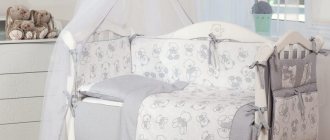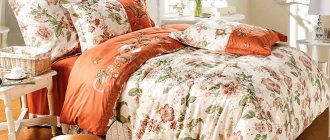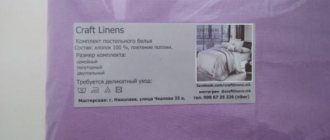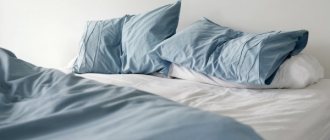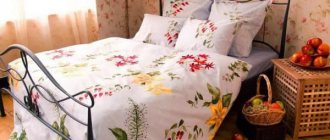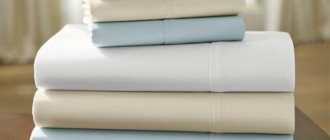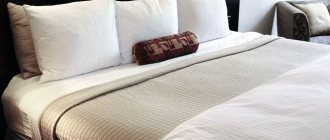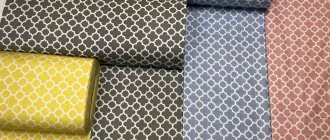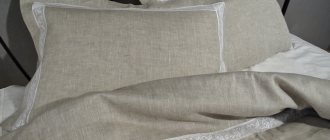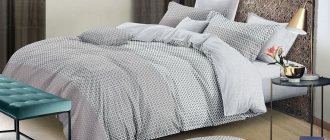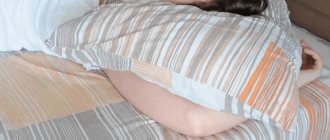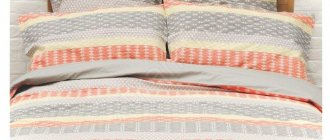Today, bedding sets made from natural cotton fabrics are especially popular. However, among the huge variety, it is not always easy to make a choice, since each type of textile differs in its external and performance qualities.
Lately, buyers have been giving preference to types such as percale or poplin. What is best for bedding will be discussed further.
Poplin or percale bedding
Percale and poplin - what's the difference?
We discussed in detail what poplin is and what percale is in other articles, so here we will only recall the main points. The weave of these fabrics is the same as calico - the simplest: linen. The differences relate to the threads used in production. Poplin is made from threads of different thicknesses: the warp is thinner than the weft. Thanks to this, the fabric becomes especially soft, creases less, and looks the same from the front and back.
Percale is woven from almost untwisted threads, glued with a special compound. The fabric becomes denser and smoother.
Comparison of percale and poplin
Therefore, percale and poplin bed linen differ in minor nuances. Poplin is softer and retains heat better. Percale is smoother and cooler to the touch. Percale wrinkles more, but lasts a little longer due to its strength and density.
Material
You've probably noticed that you want to touch the fabric of one bed linen again and again, while another set just asks you to hide it as far as possible and never put it on again. It’s easy to choose the perfect material in a store near your home. When buying online, the task becomes more complicated - you can’t touch it! But you can learn to “read” the packaging and description. This is what we will do now.
Bed linen differs in composition, type of weave of threads and density.
Compound
Based on their composition, fabrics are divided into natural, artificial, synthetic and mixed. Don't believe the stereotypes that only natural ones are good. Each material has its own advantages, the main thing is to choose the one that suits you.
| Natural fabrics | Artificial fabrics |
| Made from plant fibers. Pleasant to the touch, breathe well and wick away moisture. They cost more than synthetic ones. Materials: cotton, linen, silk. | They are created on the basis of natural materials using modern technologies. In terms of their characteristics, they are not only not inferior to natural fabrics, but often even surpass them. Materials: bamboo, modal, tencel. |
| Synthetic fabrics | Blended fabrics |
| Obtained from products of processing of natural gas and oil. They are easier to paint, look aesthetically pleasing, and dry instantly. They breathe worse and absorb moisture. They are much cheaper than natural and mixed fabrics. | Produced by combining natural and synthetic, artificial and synthetic or natural and artificial fibers. This combination allows you to find compromises. For example, cotton + polyester = a more durable and cheaper fabric that allows air to pass through and absorb moisture better than synthetics. |
Weaving Threads
Take a closer look: the fabric of your shirt differs from the fabric of the cardigan not only in color, but also in the way the threads are intertwined. It's the same story with bed linen. The texture of the fabric, its strength, practicality and durability depend on the type of weaving of the threads.
| Linen. This is the simplest type of weaving: the threads intersect crosswise through one another. Fabrics with plain weave threads are the most inexpensive, slightly rough to the touch, and have gaps. Fabrics: calico, poplin, ranfors, percale, flannel, polycotton. |
| Satin. Twisted threads in satin weave fabric intersect every 2–4 diagonally. The fabric is smooth, durable, lasts longer than fabric with plain weave threads and is more expensive. Fabrics: satin, polysatin, novo-satin, stripe-satin, mako-satin. |
| Satin. In satin weave fabric, the threads intersect at 5 or more intervals. The material turns out silky, flowing, the front side is slightly sliding. Fabrics: silk, satin. |
| Twill. In twill weaving, the threads intersect with an asymmetrical shift every 2 or 3, forming a diagonal hem. The fabric is quite tough, but very durable. Fabric: twill. |
Density
The strength and durability of bed linen depends on this parameter. The surface density of fabric is measured in grams per square meter. The lower the value, the thinner the material and the shorter its service life. A fabric that is too thick will feel harsh to the touch. Moreover, the golden mean is different for each canvas.
Thus, the optimal density for calico, poplin and satin is 110–125 g/m². For linen fabric - 125–150 g/m².
Types of fabrics for bed linen
| Textile | Photo | Advantages and disadvantages | Density (g/m²) | Comfort level | Prices on the website |
| Calico | Natural cotton fabric with plain weave threads. + Affordable. | from 110 to 125 | from 548 to 3,524 | ||
| Poplin | + Pleasant to the touch texture with a small rib (2 types of threads are used: thin longitudinal and thick transverse). | from 110 to 120 | from 816 to 7,095 | ||
| Percale | The fabric is made from high grade cotton. + Dense and smooth. | from 110 to 115 | from 1430 to 8 190 | ||
| Ranfors | It differs from the well-known calico with a particularly thin and twisted thread and a denser weave. + Smooth, soft texture. | from 120 to 125 | from 1,250 to 13,440 | ||
| Flannel | + Soft, velvety to the touch. | from 170 to 257 | from 2,430 to 5,063 | ||
| Polycotton | + Low price. | from 80 to 146 | from 998 to 1,485 | ||
| Microfiber | + Low price. | from 65 to 70 | from 365 to 2,520 | ||
| Linen fabric | + Very strong and durable. | from 120 to 150 | from 1,485 to 2,255 | ||
| Satin | + Smooth, very pleasant to the body. | from 100 to 125 | from 1,099 to 12,740 | ||
| Stripe satin | Natural satin weave fabric with a jacquard stripe pattern. + Original, elegant appearance. | from 100 to 125 | from 2,970 to 6,240 | ||
| Mako-satin | Made from high grade cotton. + Soft to the touch and durable. | from 100 to 125 | from 2,090 to 3,663 | ||
| Polysatin | Synthetic fabric with satin weave. + Smooth, shiny texture. | from 70 to 100 | from 561 to 1,151 | ||
| Novosatin | Satin weave blend fabric. + Delicate, velvety texture to the touch. | from 100 to 125 | from 1,177 to 1,403 | ||
| Natural silk | + Incredibly soft, smooth, shiny texture. | from 65 to 80 | from 3,750 to 12,060 | ||
| Rayon | + Beautiful shimmers in the light. | from 65 to 80 | from 1,168 to 3,278 |
There are other fabrics for bed linen. For example, jacquard (fabric with a pattern created by special weaving of threads) is often used to sew the outside of a duvet cover. This material is not very pleasant to the touch, but it makes the set especially beautiful.
For summer, sets are created in which, instead of a duvet cover, a light blanket made of the most delicate velsoft is provided. And terry sheets are perfect for the cold season. “Winter-summer” bed linen is very popular, where a layer of insulation is quilted to the duvet cover: no need to buy an additional winter blanket!
Which fabric is better: percale or poplin?
Both fabrics are good. Both were used in the past for making luxury bed linen and clothing. Therefore, the choice between them depends on personal preferences and conditions of use. Percale bedding is more suitable for hot summers. In winter, on the contrary, poplin bed linen seems warmer. Of course, this is largely subjective, because the density and thermal conductivity of underwear made from these fabrics are very similar.
A comparison of percale and poplin shows that bed linen sets made from these fabrics serve faithfully for many years and delight their owners. They are equally hygienic and hypoallergenic, withstand washing well, maintaining the brightness of the pattern. But percale linen still has a chance to last a little longer, although it requires more careful ironing after washing.
If someone asked me: what is the difference between percale and poplin, I would advise touching the fabrics and holding them up to the light. It will be noticeable that the percale is much denser, it is a little smoother and a little stiffer. Poplin is very soft and delicate, does not form creases when wrinkled. On the surface of poplin linen you can see a barely noticeable small scar; the back and face will most likely be completely indistinguishable. The percale is completely uniform, but the back side is slightly paler than the front side. How to decide which is better - percale or poplin?
Kinds
- Household – for sewing bed linen, clothing, bedsteads and home textiles.
- Technical – for production needs, production of awnings, tents, parachutes.
Important! Severe percale is not used in its pure form. It only serves as a basis for impregnation and subsequent processing. Moreover, napkins are not sewn from it, because the fabric is of low density.
Household material is classified according to the method of drawing:
- Bleached;
- Plain painted;
- Printed;
- Jacquard;
- Embroidered.
Technical percale meets the requirements of GOST 12125-66. It is intended for the chemical, aviation and military industries. Several types of fabric are produced: gray, desize, impregnated and plain-dyed. Treatment with chemical mixtures provides protection from fire, rotting and moisture. Durable and lightweight technical fabric has a density of 65-120 g/m
2
. Supplied in rolls of 90 and 110 cm widths.
The origin of the word "percale" is Persian, where pargalah means "rag".
Caring for poplin and percale bed linen
Both bed linen are very unpretentious in use. The only caveat is that percale linen requires more careful ironing. Otherwise, poplin or percale bedding remains equally comfortable and suitable. Bed linen will easily last five years or more if you follow simple requirements:
- Before washing, store laundry in a basket with holes where air can penetrate,
- wash at 60 degrees (no more than 80),
- You can dry your clothes in the air, even if the sun is shining,
- It is better to iron only from the inside out at a temperature of no more than 150 degrees.
Fabric selection depending on application
Not only sleep accessories are sewn from the three materials. Severe calico is used for rough upholstery of furniture. Robes, dresses and household and kitchen textiles are sewn from printed fabric.
Poplin is used for sewing wardrobe items; in addition, the fabric has gained wide popularity among modern needlewomen. It is used in sewing soft toys, jewelry, scrapbooking, patchwork, and for appliques.
Percale was originally invented for technical needs. Sails, parachutes are sewn from it, and aircraft hulls are sheathed. Bathrobes, pajamas, blouses, and dresses are made from household items.
